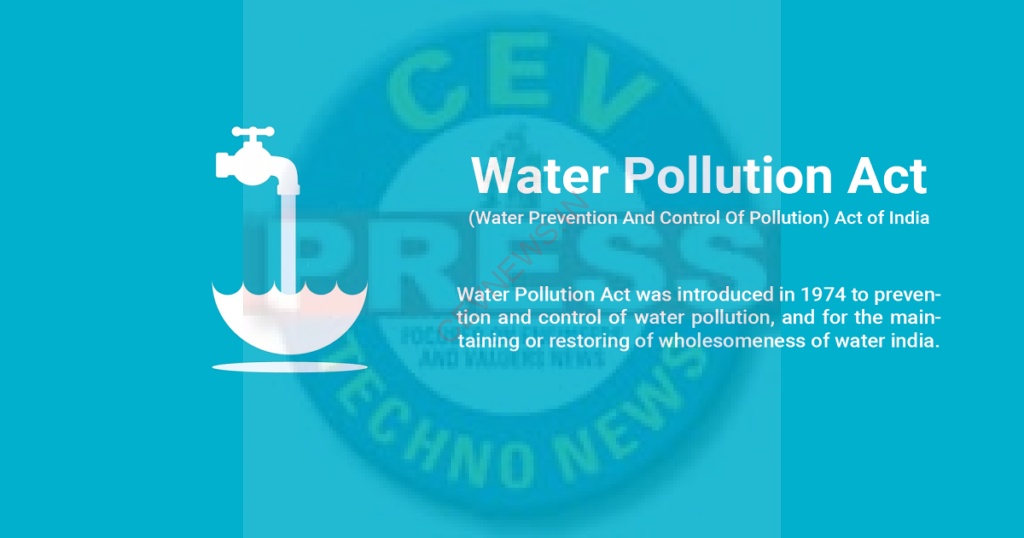Introduction
The Act came into force in 1974 and is applicable to the states of Assam, Bihar, Madhya Pradesh, Gujrat, Haryana, Tripura, West Bengal, Jammu and Kashmir, Rajasthan, Kerala, and the union territories. It could also be adopted by any state through a resolution passed declaring to adopt the Act. The Water (Prevention and Control) Act, 1974 was introduced to prevent and control water pollution and to restore and maintain the wholesomeness of water for the establishment.
The Act also confers some powers to the established bodies such as the central board and the state board to control pollution of the water bodies.
Definitions
Section 2 of the Act contain certain definitions:
- “ Board “ means either the central board or the state board.
- Section 2 (e) of the Act defines what is pollution, according to Section 2(e) pollution means any contamination of water or alteration of the physical, chemical and biological properties of water or disposing of any sewage waste in water which is likely to cause nuisance or renders such water to be harmful to public health or safety or to domestic, industrial or other legitimate use or harmful to the life and health of the animals and aquatic plants.
- Includes- watercourse (flowing or dry), inland water whether natural or artificial, subterranean water or sea or tidal waters as the state may prescribe from time to time.
- According to Section 2 (b) Central Board means Central Pollution Control Board.
- According to Section 2 (h) State Board means State Pollution Control Board.
Agencies for controlling Water Pollution
There are two agencies set up as per the Act for controlling and preventing water pollution.
Central Board- Central Pollution Control Board
Constitution and Composition (Section 3)
The Central Government through a notice in the official gazette has the power to assign or set up a Central Board named as Central Pollution Control Board. As far as the composition of the board is concerned the Central Board is to contain the following members:
- A chairman who has the knowledge or has practical experience in dealing with cases relating to environmental protection. The chairman is to be appointed by the central government only.
- Not more than 5 officials to represent the central government.
- Not more than 5 members to be nominated by the central government from the members of the State Board.
- Maximum 3 members appointed by the central government to represent the interests of agriculture, fisheries, trade or any other interest as the government may seem fit.
- 2 persons to represent the companies or corporations owned, controlled or by the central government.
- A full-time member secretary having complete knowledge, experience and qualification of scientific management and prevention of environmental pollution.
Functions of Central Board (Section 16)
- Advise the Central Government on any matter concerning the prevention and control of water pollution.
- Coordinate the activities of the State Boards and resolve disputes among them.
- provide technical assistance and guidance to the State Boards, carry out and sponsor investigations and research relating to problems of water pollution and prevention, control or abatement of water pollution.
- Plan and organize the training of persons engaged or to be engaged in for the prevention, control or abatement of water pollution on such terms and conditions as the Central Board may specify.
- Organize through mass media a comprehensive program regarding the prevention and control of water pollution.
State Board- State Pollution Control Board
Constitution and Composition (Section 4)
- The state government through an official notice in the Gazette has the power to assign or set up a state board named as State Pollution Control Board. The composition of the state board is as follows:
- A Chairman who either has the knowledge or some experience in dealing with cases relating to environmental pollution.
- Not more than 5 members appointed by the state government to represent the government.
- Not more than 2 persons by the state government who are functioning as members of the local authorities within the state
- Not more than 3 persons nominated by the state government to represent the interest of fisheries, agriculture, trade and any other interest as the government may seem fit.
- 2 person from companies, corporations which are either controlled, owned or managed by the state.
- A member secretary who has the knowledge, qualifications, and experience in dealing with cases pertaining to environmental pollution.
Functions of State Board (Section 17)
- To plan a comprehensive program for preventing and controlling the pollution of the wells and streams in the state and to secure its execution.
- To advise the State Government on matters relating to prevention and controlling water pollution.
- Collaborating with the central board to train persons employed or to be employed in preventing, controlling water pollution.
- To lay down, modify the effluent standards of sewage and trade effluents and for the quality of receiving water resulting from the discharge of effluents and to classify waters of the state.
- To evolve methods of utilizing the sewage and suitable trade effluents in agriculture.
- The state Board has the authority to set up laboratories to enable the board to perform its function efficiently, including collecting samples of water from any stream or sewage or trade effluents.
Prevention and Control of Water Pollution
According to Section 19 of the Act, the state board has the power to limit the territorial jurisdiction of any order passed by it in matters relating to prevention and controlling water pollution. This means that the orders passed by the state board will only apply in the areas that are affected by water pollution .it is up to the state board to determine which area is to be declared water polluted and which is not, this can be done by making reference to a map or making reference to a line of any watershed or the boundary of any district.

